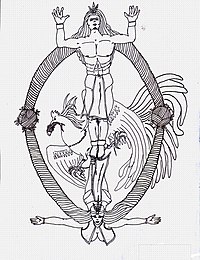Diwata
| Diwata | |
|---|---|

Entities from Filipino mythology; a diwata is depicted at the bottom
|
|
| Title | Diwata |
| Description | lesser gods and goddesses, guardian spirits |
| Gender | Male/female |
| Equivalent |
Deity Fairy Nymph |
In Philippine mythology, a diwata (derived from Sanskrit devata देवता; encantada in Spanish) is a type of deity or spirit. The term "diwata" has taken on levels of meaning since its assimilation into the mythology of the pre-colonial Filipinos. It has its origin in the devata beings from Hinduism and Buddhism.
When the Spanish conquered the Philippines the commonly used meaning of the term reduced from goddess to dryad-like spirit which was considered benevolent or neutral. These spirits were invoked ritually for positive crop growth, health, and fortune; however, they were also considered to be able to incur illness or misfortune if not given proper respect.
They were said to reside in large trees, such as acacia and balete and were understood as the guardian spirits of nature: casting blessings or curses upon those who brought benefits or harm to the forests and mountains.
In modern times, the term "diwata" is sometimes loosely used to refer to a generic type of beings, much like "elf" or "fairy," or very specific types. The term "diwata" is synonymous to "anito" and the usage of the word "diwata" is more prevalent in the southern Philippines, while "anito" takes its place in the northern areas.
Although there are numerous and varied accounts as to what they should look like, a general trend may be observed in that they are normally human in appearance—beautiful and seemingly ageless at that—save for some distinct characteristics. This may take the form of not having a philtrum or having continuously smooth and supple skin that somehow resemble fingernails, without any wrinkled parts as in the elbows and knees. They tend to be fairer than average, as pale skin has been associated with the supernatural even during pre-colonial times (for example, the "white lady" belief is prevalent in the East and Southeast Asian regions).
Visayan epics such as Hinilawod described them as very beautiful, some having golden skin, other having luminous fair skin.
...
Wikipedia
